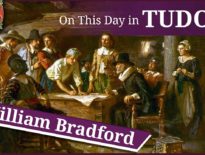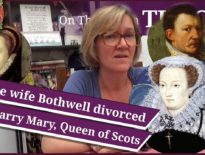On this day in Tudor history, 8th May 1508, herald and chronicler Charles Wriothesley was born in London.
Wriothesley’s chronicle is one of the major primary sources for King Henry VIII's reign, so let me tell you more about its writer, Charles Wriothesley, Windsor Herald, and what heralds actually are.
- College of Arms website - https://www.college-of-arms.gov.uk/about-us/heralds-officers
- Wriothesley's Chronicle Volume I - https://archive.org/stream/chronicleofengla01wriouoft#page/n5/mode/2up, and
Volume II - https://archive.org/details/chronicleofengla02wriouoft/page/n4/mode/2up
Also on this day in Tudor history, 8th May 1559, Queen Elizabeth I gave her approval to the Acts of Uniformity and Supremacy. The Act of Uniformity was incredibly important and it reflected the queen's wish to follow a middle road where religion was concerned. But what was this act? What did it establish? What did Elizabeth want for England and what happened? Find out in last year’s video:
And in 1536, in the lead-up to Queen Anne Boleyn’s fall, vultures were circling, hands were being rubbed with glee, but who were these vultures and what were they after- Find out in 8th May 1536 video:
Also on this day in history:
- 1538 – Death of Edward Fox, Bishop of Hereford and diplomat. He was active in trying to secure the annulment of Henry VIII's marriage to Catherine of Aragon, and produced several books and polemics on Henry's Great Matter, including Henricus octavus.
- 1539 – The troops mustered between Whitechapel and Mile End marched through the City and Westminster to St James's, where Henry VIII reviewed them. This was in response to the war panic caused by Francis I and Charles V signing the Peace of Toledo.
- 1546 – Death of Thomas Knollys, President of Magdalen College, University of Oxford, from 1528 to 1536. In 1536, Knollys became Vicar of South Kirlby and died there in 1546. He was buried at Wakefield.
Transcript:
On this day in Tudor history, 8th May 1508, herald and chronicler Charles Wriothesley was born in London.
Wriothesley’s chronicle is one of the major primary sources for Henry VIII's reign, and I use it several times a week in my research.
Let me tell you a bit more about Charles Wriothesley, and I’ll also give you a link to read his chronicle in the description for this talk...
• Charles came from a family of heralds; he was the younger son of Sir Thomas Wriothesley, Garter King of Arms, grandson of John Writhe, Garter King of Arms, and nephew of William Wriothesley, York Herald.
• From the age of 3, he was brought up at Garter House, a mansion that was built by his father, Thomas, in Barbican Street, Cripplegate, in London.
• He was educated at Trinity Hall, Cambridge, which his cousin, Thomas, future Lord Chancellor to King Henry VIII also attended.
• At the age of just 16, in 1524, Wriothesley was appointed Rouge Croix Pursuivant, a junior officer of arms of the College of Arms. It is thought that he also began service to Thomas Audley at this time.
• In 1529, he became a gentleman of Gray’s Inn, one of the four inns of the court in London.
• As herald, he attended the ceremony in which Anne Boleyn was created Marquess of Pembroke in September 1532, and her coronation in 1533, which was the first major event that he recorded in his chronicle in detail from a personal perspective, as he witnessed it. His chronicle, however, does go back to the start of the Tudor dynasty, and he used Richard Arnold’s chronicle as a source for this. His biographer Gordon Kipling describes how he saw his chronicle as “not just as a personal document, but also as a record of the dynasty he served as perceived from the viewpoint of the city of London” and that he “strove to create a chronicle at once loyal and carefully observant.”
• In late 1534, he became Windsor Herald of Arms in Ordinary, but that was the height of his career as a herald, and he did not go as far as his father and grandfather. Perhaps this was due to the death of Audley in 1544 and then the fall of his cousin, Thomas, in 1547.
• It is thought that he married twice, but there’s no mention of any children.
• Wriothesley died on 25th January 1562 at his lodgings in the home of painter-stainer Sampson Camden, and was laid to rest at St Sepulchre’s, Holborn, in a lavish funeral paid for by his fellow heralds.
• Wriothesley, as I said, was a herald. If you’re wondering what that means, a herald is an officer of the College of Arms whose job it is to oversee state ceremonial, precedence, and the use of armorial bearings, and (historically) to make proclamations, carry official messages, and oversee tournaments. The College of Arms was founded by King Richard III in 1484 and it is still going today. Traditionally, there are six kings of arms, the senior rank; six heralds, and four pursuivants of arms, the junior rank. These are overseen by the Earl Marshal.



Thank you! I’ve always wondered about the heralds of chroniclers. Michelle t